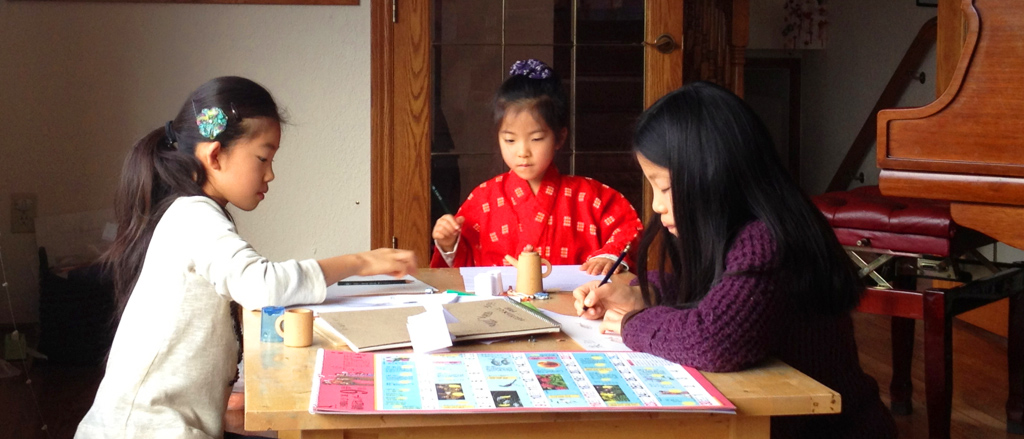
How can I homeschool multiple children? If you’ve asked this question, you’re in good company. Meeting the needs of multiple children is a challenge for any parent. But homeschooling parents needs to be able to do it all day long. How is that possible?
There is No One Right Way
Homeschooling families run a wide gamut, from “regimented” to “easygoing.” Where does your family fit on this spectrum? Some parents would ideally prefer a more structured approach, but reality requires them to be more laid-back to make it work. Others find that a carefully planned rhythm helps them stay on track with everyone’s needs.
 Set the tone of adaptability in your home and model it for your children to follow. If you are calm, creative, and flexible in meeting their needs, they will learn in time to be patient and flexible in getting their own needs met.
Set the tone of adaptability in your home and model it for your children to follow. If you are calm, creative, and flexible in meeting their needs, they will learn in time to be patient and flexible in getting their own needs met.
Oak Meadow is designed to be highly adaptable. You may find that you want to go more in-depth with some lessons and skim through others. Some lessons can be modified so that children at multiple levels can learn from them. If two or more of your children are close in age or at developmentally similar levels, you might simplify things by working with them at a single level.
If you need help with adjusting Oak Meadow curriculum to meet your family’s specific situation, consider consulting with an experienced Oak Meadow teacher for suggestions.
Let Your Observations Guide You
Think about each of your children individually. What engages each one’s attention like nothing else? Use your observations to create tools that help them stay occupied while you are working with the others. Finding safe, reliable ways to keep little hands and minds busy when you need it will go a long way. One idea is to create a “Choice Time’ bag. This is a bag filled with rotating activities (no more than 3 at a time) that students can choose to engage with at a special ‘choice time’ during the day. Choosing fun activities that your student can do only during this time will keep their interest high and will allow you to focus your attention elsewhere. For additional inspiration, Oak Meadow’s Pinterest boards are full of helpful activity ideas.
Keep an open mind about the times of day when you work with your older children. While you may be able to work as a family on crafts and projects, older students with longer readings may have difficulty finding quiet time away from younger kids during the day to complete this work. Consider setting aside time on the weekends or evenings for quiet, concentrated activities.
Consider also when your youngest children need your attention the most – and least. Are they happiest sharing your attention mid-morning or just after a nap?
Create a Predictable but Flexible Rhythm
By using your children’s own rhythms as a starting point for the whole family’s rhythm, you can maximize the chance of success. When everyone in the family knows what to expect, less time is spent in communication about what each day will hold. Provide a general rhythm to guide the whole family. Perhaps your homeschool rhythm flows best around mealtimes, naptimes, and bedtimes. Post a simple chart of your rhythm that everyone can understand and try to follow. Or have your student create a checklist of what is due each day so they can move through activities with needing to involve the parent—plus you may find that your student enjoys having the ability to choose how they want to approach the day. If you try something and it doesn’t work, use that information to adjust and continue moving forward.
Capitalize on Their Independence
 In what ways can each child be independent? Independence for an older child might mean reading or working on lessons by themselves for a set period of time. For a baby, independence might mean naptime, time with toys on the floor, or an extended ride on someone’s back.
In what ways can each child be independent? Independence for an older child might mean reading or working on lessons by themselves for a set period of time. For a baby, independence might mean naptime, time with toys on the floor, or an extended ride on someone’s back.
The ability to work independently is also something that can be built up over time. Try creating a chart to allow your students to set goals and track their progress reading or working on their own. Small increases every day can lead to big gains in your child’s ability to work independently for extended periods of time.
Your children can also support you as you juggle responsibilities. Can the olders amuse the youngers while the middles get needed attention? Even young “big siblings” can sometimes successfully engage very little ones with funny faces, rhyming songs, finger plays, stories, and toys. In some larger families, each older child is paired up with a younger child. If your older children are not yet at this stage, consider inviting a homeschooled teen to help you out on a regular basis.
Prioritize Thoughtfully
Just as important as the ways in which your children can be independent are the ways each is not able to work without your help. Where do they need your attention most? Make those moments count. You may need to spend some time observing and assessing your children to figure out where they need the greatest support. If you have to ask a child to wait for your attention, acknowledge that you are asking them to do something important and helpful. The most successful cooperation happens when those involved feel their needs are recognized and valued.
Take Time to Recharge
Always remember to take care of your own basic needs so that you can be as patient, creative, and flexible as possible. Homeschooling multiple children is a mighty challenge. Try to connect with others who share your values, can relate to your struggles, and can offer ideas that you might not have thought of. You might consider homeschooling cooperatively with another family or group to share the load. Maintain patience. Feed your own needs so that you have plenty of inner reserves when you most require them. Approach the issue of nurturing multiple children as a problem that can and will be solved.
Keep It All in Perspective
When you have a challenging day or week, remind yourself why you started homeschooling in the first place. Chances are your reasons for homeschooling will be much more compelling than your challenges. Seek ideas and support from others who have been in similar shoes. Do all you can to savor the time you have at home with your children, because this time with your children is just a season. Love your children, be responsive to their needs, do your best to be flexible and adaptable in your approach to homeschooling, and trust that it will be enough.